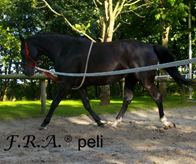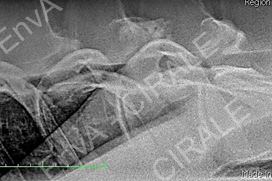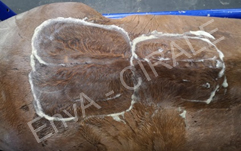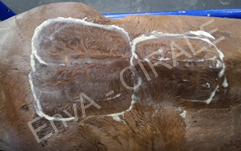This case has been kindly provided by Dr. Claire Moiroud (DVM, DESV, Dipl. ECVSMR, Dipl. ACVSMR, ISELP Certified) from CIRALE (Centre d’Imagerie et de Recherche sur les Affections Locomotrices Equines – Normandy, France), part of the French National Veterinary School of Alfort (EnvA, France).
CIRALE is renowned worldwide as a reference center for the study of locomotor disorders and causes of underperformance in sport and racehorses. The facility has cutting edge imaging and rehabilitation equipment and is managed by renowned Pr. Fabrice Audigié and Pr. Jean-Marie Denoix.
HISTORY
– 9 year-old Thoroughbred gelding
– Retired racehorse
– Light daily in-hand activity because the horse does not tolerate a saddle nor a surcingle
– Marked back stiffness and back myopenia
– With a saddle: irregular gait at trot, small bucks at gallop for the first strides and then the horse stays very stiff, gallops with a rounded back like an unbroken horse
CLINICAL EXAMINATION
Physical examination
– Back ad neck myopenia
– Marked decreased range of motion and sensitivity on passive mobilisations of the back, severe on the thoraco-lumbar area
Dynamic examination
– Marked back and neck stiffness, short strides
– Stiffness increased with a saddle : bucks, irregular gait at trot, gallops with a rounded back like an unbroken horse
– LF lameness (fetlock)
TREATMENT 1
Low frequency ultrasound therapy
1st treatment: D0, D0+48h, D0+2weeks
Grey transducer
⇒ focused over T17-T18 articular processes, 90% power output, 30s per side
Red transducer followed by Blue transducer, 90-100% output power
⇒ T16-L1 area
. → 2 min per side with each transducer
⇒ L3-L5 area (larger area over the lumbar muscles)
. → 3 min per side with each transducer
OUTCOME 1 – after 1st treatment
Improvement of the tolerance of the saddle: the horse bucks less and can gallop quite normally
– Improvement of the tolerance of the saddle : the horse bucks less and can gallop quite normally
– Improvement seen right after the first application
– Lasting and cumulative effect (evaluation at D+2weeks > D+48h > D0)
– The horse can now work with a Peli® on lunge
– No effect on the passive mobilisations of the back

TREATMENT 2
Low frequency ultrasound therapy
2nd treatment (1 month after the 1st): once a week, 3 weeks
Red transducer followed by Blue transducer, 95-100% output power
⇒ T16-L1 area
. → 2 min per side with each transducer
⇒ L3-L5 area (larger area over the lumbar muscles)
. → 3 min per side with each transducer
OUTCOME 2 – after 2nd treatment
– Still improved before the second treatment in comparison with D0
– More improvement after further treatments
– Still improved before the second treatment in comparison with D0
– More improvement after further treatments
– At work, the rider finds that the horse is more flexible quickly and that he is « happier» at work
– The horse now tolerates a surcingle and can be trained with long reins
– Improvement of his body condition + better hair coat
Some improvement of the passive mobilisations of the back, especially at the thoraco-lumbar junction
– Some recurrence of the signs of intolerance of the saddle/surcingle 3 weeks after the last treatment
– Nevertheless, the horse is still better in comparison with D0 and can be trained with long reins, more willing to work, more flexible quickly
DISCUSSION
Virtuous circle on this case:
– Treatment enables the use of training aids ⇒ improvement of attitude at work ⇒ contribute to improvement of clinical signs
– Improvement may be due to heating effect and muscle relaxation
Biases may exist:
– Repetition of evaluation with the saddle: habituation effect ??
– The rider does not think so… Before treatment, even after many attempts to use a surcingle or a Peli, the horse never tolerated those training aids.
CONCLUSION
– Low frequency ultrasound therapy seems to have been beneficial to this horse on back pain
– To be continued…




